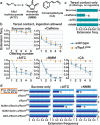Analysis of Drosophila TRPA1 reveals an ancient origin for human chemical nociception
- PMID: 20237474
- PMCID: PMC2845738
- DOI: 10.1038/nature08848
Analysis of Drosophila TRPA1 reveals an ancient origin for human chemical nociception
Abstract
Chemical nociception, the detection of tissue-damaging chemicals, is important for animal survival and causes human pain and inflammation, but its evolutionary origins are largely unknown. Reactive electrophiles are a class of noxious compounds humans find pungent and irritating, such as allyl isothiocyanate (in wasabi) and acrolein (in cigarette smoke). Diverse animals, from insects to humans, find reactive electrophiles aversive, but whether this reflects conservation of an ancient sensory modality has been unclear. Here we identify the molecular basis of reactive electrophile detection in flies. We demonstrate that Drosophila TRPA1 (Transient receptor potential A1), the Drosophila melanogaster orthologue of the human irritant sensor, acts in gustatory chemosensors to inhibit reactive electrophile ingestion. We show that fly and mosquito TRPA1 orthologues are molecular sensors of electrophiles, using a mechanism conserved with vertebrate TRPA1s. Phylogenetic analyses indicate that invertebrate and vertebrate TRPA1s share a common ancestor that possessed critical characteristics required for electrophile detection. These findings support emergence of TRPA1-based electrophile detection in a common bilaterian ancestor, with widespread conservation throughout vertebrate and invertebrate evolution. Such conservation contrasts with the evolutionary divergence of canonical olfactory and gustatory receptors and may relate to electrophile toxicity. We propose that human pain perception relies on an ancient chemical sensor conserved across approximately 500 million years of animal evolution.
Figures




Similar articles
-
Modulation of TRPA1 thermal sensitivity enables sensory discrimination in Drosophila.Nature. 2011 Dec 4;481(7379):76-80. doi: 10.1038/nature10715. Nature. 2011. PMID: 22139422 Free PMC article.
-
Drosophila TRPA1 channel mediates chemical avoidance in gustatory receptor neurons.Proc Natl Acad Sci U S A. 2010 May 4;107(18):8440-5. doi: 10.1073/pnas.1001425107. Epub 2010 Apr 19. Proc Natl Acad Sci U S A. 2010. PMID: 20404155 Free PMC article.
-
Response of Drosophila to wasabi is mediated by painless, the fly homolog of mammalian TRPA1/ANKTM1.Curr Biol. 2006 May 23;16(10):1034-40. doi: 10.1016/j.cub.2006.04.002. Epub 2006 Apr 27. Curr Biol. 2006. PMID: 16647259
-
Temperature sensation in Drosophila.Curr Opin Neurobiol. 2015 Oct;34:8-13. doi: 10.1016/j.conb.2015.01.002. Epub 2015 Jan 21. Curr Opin Neurobiol. 2015. PMID: 25616212 Free PMC article. Review.
-
Drosophila sensory receptors-a set of molecular Swiss Army Knives.Genetics. 2021 Mar 3;217(1):1-34. doi: 10.1093/genetics/iyaa011. Genetics. 2021. PMID: 33683373 Free PMC article. Review.
Cited by
-
Thermal infrared directs host-seeking behaviour in Aedes aegypti mosquitoes.Nature. 2024 Sep;633(8030):615-623. doi: 10.1038/s41586-024-07848-5. Epub 2024 Aug 21. Nature. 2024. PMID: 39169183 Free PMC article.
-
Drosophila ppk19 encodes a proton-gated and mechanosensitive ion channel.Sci Rep. 2022 Nov 1;12(1):18346. doi: 10.1038/s41598-022-23236-3. Sci Rep. 2022. PMID: 36319833 Free PMC article.
-
Chemosensory properties of the trigeminal system.ACS Chem Neurosci. 2011 Jan 19;2(1):38-50. doi: 10.1021/cn100102c. Epub 2010 Dec 22. ACS Chem Neurosci. 2011. PMID: 22778855 Free PMC article. Review.
-
Residues in the pore region of Drosophila transient receptor potential A1 dictate sensitivity to thermal stimuli.J Physiol. 2013 Jan 1;591(1):185-201. doi: 10.1113/jphysiol.2012.242842. Epub 2012 Oct 1. J Physiol. 2013. PMID: 23027824 Free PMC article.
-
Gustatory-mediated avoidance of bacterial lipopolysaccharides via TRPA1 activation in Drosophila.Elife. 2016 Jun 14;5:e13133. doi: 10.7554/eLife.13133. Elife. 2016. PMID: 27296646 Free PMC article.
References
-
- Eisner T. In: Chemical Ecology. Sondheimer E, Simeone JB, editors. Academic Press; New York: 1970. Vol.
-
- Thorne N, Chromey C, Bray S, Amrein H. Taste perception and coding in Drosophila. Curr Biol. 2004;14:1065–1079. - PubMed
-
- Wang Z, Singhvi A, Kong P, Scott K. Taste representations in the Drosophila brain. Cell. 2004;117:981–991. - PubMed
Publication types
MeSH terms
Substances
Grants and funding
LinkOut - more resources
Full Text Sources
Other Literature Sources
Molecular Biology Databases

